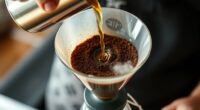To develop your coffee palate, actively engage your senses by tasting a variety of brews and noting their unique flavors and aromas. Use flavor maps, standard descriptors, and keep a journal to track your impressions over time. Practice blind tastings and compare different coffees to sharpen your perception. Building your vocabulary helps you describe what you taste more precisely. Keep practicing regularly, and you’ll uncover deeper appreciation and enjoyment in every cup—if you continue exploring, you’ll discover even more.
Key Takeaways
- Engage your senses actively by tasting a variety of coffees and noting distinct flavor profiles regularly.
- Use flavor maps, sensory lexicons, and descriptive terminology to expand your flavor vocabulary.
- Conduct blind tastings and compare coffees side-by-side to sharpen perception and reduce biases.
- Keep a coffee journal to track impressions, preferences, and evolving taste recognition over time.
- Sample coffees from different regions, processing methods, and roast levels to develop a nuanced palate.

Developing your coffee palate is an engaging process that sharpens your ability to identify and appreciate the diverse flavors in coffee. It’s about more than just drinking; it’s about actively engaging your senses through coffee tasting.
Enhance your coffee experience by actively engaging your senses to discover a world of diverse flavors.
As you taste different coffees, you begin to recognize distinct flavor profiles and nuances that make each cup unique. This process enhances your flavor recognition skills, allowing you to distinguish subtle tastes and aromas that might otherwise go unnoticed. Developing your palate involves consistent practice, where you pay close attention to tasting notes and build a mental catalog of flavors derived from various coffee origins and roast levels.
Using tools like the sensory lexicon from the World Coffee Research helps you communicate and understand complex flavors more precisely. This lexicon provides standardized tasting descriptors, which improve your ability to identify specific flavor nuances during coffee cupping sessions or casual tastings. Additionally, understanding the beneficial ingredients like collagen and hyaluronic acid found in eye patches can inform you about their nourishing properties for delicate skin.
As you familiarize yourself with these terms, your sensory vocabulary expands, making it easier to describe what you perceive and deepen your appreciation for different coffee styles. Incorporating flavor maps into your tasting routine also supports palate development by visually linking aromas and tastes to specific origins or processing methods. These visual guides help you recognize patterns and broaden your understanding of how different factors influence flavor.
Keeping a coffee journal is a powerful way to track your progress. Record your impressions, noting the tasting notes, aroma profiles, and overall balance of each coffee. Over time, this practice highlights your evolving palate and helps you identify your preferences and areas for growth.
Comparing coffees side-by-side, especially during blind tastings, sharpens your perception by eliminating biases and forcing your senses to work more critically. This exercise accelerates your palate development, making you more adept at identifying subtle flavor differences and recognizing the complexity of coffee’s flavor profile.
Consistency is key. Regularly tasting a variety of coffees, from different regions and roast levels, creates a broad sensory experience. This variety strengthens your ability to develop a nuanced palate, where you can more readily distinguish the delicate flavor nuances that define high-quality coffee.
Over time, your tasting skills become more refined, and your appreciation for the artistry behind each brew deepens. Developing your coffee palate is a journey of exploration and learning, turning each cup into an opportunity to discover new flavors, improve your sensory skills, and elevate your overall coffee experience.
Frequently Asked Questions
How to Improve Your Palate for Coffee?
To improve your palate for coffee, start by tasting a variety of beans from different origins and roasts. Use tools like flavor wheels and aroma kits to identify flavors, and keep a journal to track your impressions.
Practice active tasting by noting textures and aftertastes, and compare coffees side-by-side or in blind tests. Over time, you’ll sharpen your ability to distinguish subtle differences and expand your flavor recognition.
Is It Possible to Improve Your Palate?
Yes, you can improve your palate. By regularly tasting a variety of coffees, you sharpen your sensory skills and learn to identify subtle flavors.
Using tools like flavor maps and keeping detailed notes helps you recognize complex notes more easily.
Consistent practice, blind tastings, and expanding your flavor vocabulary all contribute to enhancing your ability to distinguish and appreciate different coffee profiles over time.
How to Cleanse Your Palate for Coffee Tasting?
To cleanse your palate for coffee tasting, start by drinking plain, room-temperature water between sips to rinse away residual flavors.
Use neutral palate cleansers like plain bread or unsalted crackers to absorb lingering tastes.
Avoid strong-flavored foods beforehand, as they can alter your perception.
Remember to spit out the coffee and cleansers instead of swallowing, and switch to water regularly to stay sensitive and prevent flavor fatigue.
How Do I Drink Coffee if I Hate the Taste?
If you hate the taste of coffee, start by mixing it with milk or sweeteners to soften the bitterness.
Choose milder, lower-acid brews with chocolate or caramel flavors, and take small sips to gradually get used to the flavor.
Experiment with brewing methods like cold brew or French press for smoother tastes.
Keep a tasting journal to track what works best, helping you build a more enjoyable coffee experience over time.
Conclusion
By exploring different beans, brewing methods, and tasting notes, you’ll gradually refine your coffee palate. Trust your senses, take notes, and don’t be afraid to try new flavors. With patience and curiosity, you’ll start to notice the subtle complexities in every cup. Keep experimenting and savoring each sip—your coffee journey is a personal adventure. Before long, you’ll confidently identify your favorites and truly appreciate what makes each brew special.









